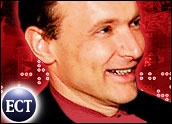
Tim Berners-Lee, the inventor of the World Wide Web and Director of the World Wide Web Consortium (W3C) was dubbed a Knight Commander, Order of the British Empire by Queen Elizabeth II during an investiture in London today. The rank of Knight Commander is the second most senior rank of the Order of the British Empire, one of the Orders of Chivalry.
Sir Timothy Berners-Lee, a British citizen who lives in the United States, was knighted in recognition for his “services to the global development of the Internet” through his invention of the World Wide Web.
He coined the name “World Wide Web,” wrote the first Web server, “httpd,” and the first Web client program in October 1990. He wrote the first version of the document formatting language with the capability for hypertext links, known as HyperText Markup Language.
Berners-Lee ‘Humbled’
During the hour-long ceremony held in the Ballroom at Buckingham Palace, Queen Elizabeth dubbed Sir Timothy Berners-Lee Knight Commander using the sword that belonged to her father, King George VI. He was previously honored in 2002 at Buckingham Palace by Prince Philip, Duke of Edinburgh, who awarded him the Albert Medal of the Royal Society of the Arts.
“I am humbled by this great honor,” said Sir Timothy. “The Web came about through an ongoing collaboration with my fellow inventors and developers worldwide. Everyone in the Internet community should be recognized by this honor.”
He continued, “The Web must remain a universal medium, open to all and not biasing the information it conveys. As the technology becomes ever more powerful and available, using more kinds of devices, I hope we learn how to use it as a medium for working together, and resolving misunderstandings on every scale.”
Sir Timothy’s commitment to universal access and open standards for the Web was a driving force behind his founding of the W3C in 1994 at the Massachusetts Institute of Technology, together with support from the late Michael Dertouzos, then director of the laboratory of computer science at MIT.
Goals of W3C
Today, the W3C is known as the international organization that establishes technical standards for Web infrastructure and applications. W3C consists of nearly 400 member organizations worldwide with technical teams at the Massachusetts Institute of Technology’s computer science artificial intelligence laboratory in the United States, the European Research Consortium for Informatics and Mathematics (ERCIM) in France, and Keio University in Japan.
The goal of W3C and its members is to lead the Web to its full potential by developing standard technologies — specifications, guidelines, software and tools — that will create a forum for information, commerce, inspiration, independent thought and collective understanding.
While working in 1980 as a consultant software engineer at CERN, the European Particle Physics Laboratory in Geneva, Switzerland, Sir Timothy wrote his own private program for storing information using the kind of random associations the brain makes. The “Enquire” program, which was never published, formed the conceptual basis for his future development of the Web.
Subsequently, he proposed a global hypertext project at CERN in 1989, and by December 1990, the program “WorldWideWeb” became the first successful demonstration of Web clients and servers working over the Internet. All of his code was made available free on the Internet at large in the summer of 1991.
Berners-Lee Background
A London native, Sir Timothy graduated with a degree in physics from Queen’s College at Oxford University, England in 1976. While there, he built his first computer with a soldering iron, an M6800 processor and an old television. He has since been awarded several honorary doctorates from universities around the world, including his alma mater in 2001. At MIT, he is the holder of the 3Com Founders Chair, and holds the position of Senior Research Scientist at CSAIL.
Cited by Time magazine as one of the 100 greatest minds of the twentieth century, Sir Timothy is a Distinguished Fellow of the British Computer Society and a member of the American Academy of Arts and Sciences. He received a MacArthur Fellowship in 1998, was named a Fellow of the Royal Society in 2001 and received the Japan Prize in 2002.
In June 2004, Sir Timothy received the inaugural Millennium Technology Prize in Helsinki, Finland. The honor is bestowed by the Finnish Technology Award Foundation as an international acknowledgement for “an outstanding innovation that directly promotes people’s quality of life, is based on humane values, and encourages sustainable economic development.”
In choosing Sir Timothy, the Finnish prize committee acknowledged the importance of his decision not to commercialize or patent the technologies he developed.





















































